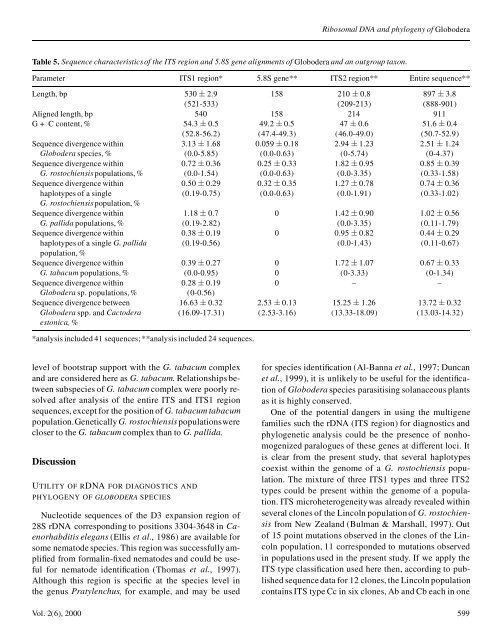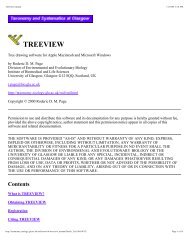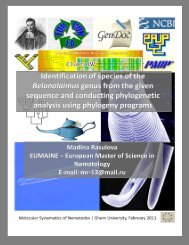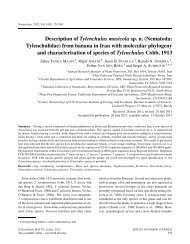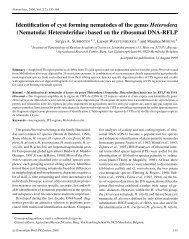Variations in ribosomal DNA sequences and phylogeny of - Russian ...
Variations in ribosomal DNA sequences and phylogeny of - Russian ...
Variations in ribosomal DNA sequences and phylogeny of - Russian ...
You also want an ePaper? Increase the reach of your titles
YUMPU automatically turns print PDFs into web optimized ePapers that Google loves.
Ribosomal <strong>DNA</strong> <strong>and</strong> <strong>phylogeny</strong> <strong>of</strong> Globodera<br />
Table 5. Sequence characteristics<strong>of</strong> the ITS region <strong>and</strong> 5.8S gene alignments <strong>of</strong> Globodera <strong>and</strong> an outgroup taxon.<br />
Parameter ITS1 region* 5.8S gene** ITS2 region** Entire sequence**<br />
Length, bp 530 § 2.9 158 210 § 0.8 897 § 3.8<br />
(521-533) (209-213) (888-901)<br />
Aligned length, bp 540 158 214 911<br />
G + C content, % 54.3 § 0.5 49.2 § 0.5 47 § 0.6 51.6 § 0.4<br />
(52.8-56.2) (47.4-49.3) (46.0-49.0) (50.7-52.9)<br />
Sequence divergence with<strong>in</strong> 3.13 § 1.68 0.059 § 0.18 2.94 § 1.23 2.51 § 1.24<br />
Globodera species, % (0.0-5.85) (0.0-0.63) (0-5.74) (0-4.37)<br />
Sequence divergence with<strong>in</strong> 0.72 § 0.36 0.25 § 0.33 1.82 § 0.95 0.85 § 0.39<br />
G. rostochiensis populations, % (0.0-1.54) (0.0-0.63) (0.0-3.35) (0.33-1.58)<br />
Sequence divergence with<strong>in</strong> 0.50 § 0.29 0.32 § 0.35 1.27 § 0.78 0.74 § 0.36<br />
haplotypes <strong>of</strong> a s<strong>in</strong>gle (0.19-0.75) (0.0-0.63) (0.0-1.91) (0.33-1.02)<br />
G. rostochiensis population, %<br />
Sequence divergence with<strong>in</strong> 1.18 § 0.7 0 1.42 § 0.90 1.02 § 0.56<br />
G. pallida populations, % (0.19-2.82) (0.0-3.35) (0.11-1.79)<br />
Sequence divergence with<strong>in</strong> 0.38 § 0.19 0 0.95 § 0.82 0.44 § 0.29<br />
haplotypes <strong>of</strong> a s<strong>in</strong>gle G. pallida (0.19-0.56) (0.0-1.43) (0.11-0.67)<br />
population, %<br />
Sequence divergence with<strong>in</strong> 0.39 § 0.27 0 1.72 § 1.07 0.67 § 0.33<br />
G. tabacum populations, % (0.0-0.95) 0 (0-3.33) (0-1.34)<br />
Sequence divergence with<strong>in</strong> 0.28 § 0.19 0 – –<br />
Globodera sp. populations, % (0-0.56)<br />
Sequence divergence between 16.63 § 0.32 2.53 § 0.13 15.25 § 1.26 13.72 § 0.32<br />
Globodera spp. <strong>and</strong> Cactodera (16.09-17.31) (2.53-3.16) (13.33-18.09) (13.03-14.32)<br />
estonica, %<br />
*analysis <strong>in</strong>cluded 41 <strong>sequences</strong>; **analysis <strong>in</strong>cluded 24 <strong>sequences</strong>.<br />
level <strong>of</strong> bootstrap support with the G. tabacum complex<br />
<strong>and</strong> are considered here as G. tabacum. Relationships between<br />
subspecies <strong>of</strong> G. tabacum complex were poorly resolved<br />
after analysis <strong>of</strong> the entire ITS <strong>and</strong> ITS1 region<br />
<strong>sequences</strong>, except for the position <strong>of</strong> G. tabacum tabacum<br />
population.Genetically G. rostochiensis populationswere<br />
closer to the G. tabacum complex than to G. pallida.<br />
Discussion<br />
UTILITY OF R<strong>DNA</strong> FOR DIAGNOSTICS AND<br />
PHYLOGENY OF GLOBODERA SPECIES<br />
Nucleotide <strong>sequences</strong> <strong>of</strong> the D3 expansion region <strong>of</strong><br />
28S r<strong>DNA</strong> correspond<strong>in</strong>g to positions 3304-3648 <strong>in</strong> Caenorhabditis<br />
elegans (Ellis et al., 1986) are available for<br />
some nematode species. This region was successfully ampli�<br />
ed from formal<strong>in</strong>-� xed nematodes <strong>and</strong> could be useful<br />
for nematode identi� cation (Thomas et al., 1997).<br />
Although this region is speci� c at the species level <strong>in</strong><br />
the genus Pratylenchus, for example, <strong>and</strong> may be used<br />
for species identi� cation (Al-Banna et al., 1997; Duncan<br />
et al., 1999), it is unlikely to be useful for the identi� cation<br />
<strong>of</strong> Globodera species parasitis<strong>in</strong>g solanaceous plants<br />
as it is highly conserved.<br />
One <strong>of</strong> the potential dangers <strong>in</strong> us<strong>in</strong>g the multigene<br />
families such the r<strong>DNA</strong> (ITS region) for diagnostics <strong>and</strong><br />
phylogenetic analysis could be the presence <strong>of</strong> nonhomogenized<br />
paralogues <strong>of</strong> these genes at different loci. It<br />
is clear from the present study, that several haplotypes<br />
coexist with<strong>in</strong> the genome <strong>of</strong> a G. rostochiensis population.<br />
The mixture <strong>of</strong> three ITS1 types <strong>and</strong> three ITS2<br />
types could be present with<strong>in</strong> the genome <strong>of</strong> a population.<br />
ITS microheterogeneitywas already revealed with<strong>in</strong><br />
several clones <strong>of</strong> the L<strong>in</strong>coln population <strong>of</strong> G. rostochiensis<br />
from New Zeal<strong>and</strong> (Bulman & Marshall, 1997). Out<br />
<strong>of</strong> 15 po<strong>in</strong>t mutations observed <strong>in</strong> the clones <strong>of</strong> the L<strong>in</strong>coln<br />
population, 11 corresponded to mutations observed<br />
<strong>in</strong> populations used <strong>in</strong> the present study. If we apply the<br />
ITS type classi� cation used here then, accord<strong>in</strong>g to published<br />
sequence data for 12 clones, the L<strong>in</strong>coln population<br />
conta<strong>in</strong>s ITS type Cc <strong>in</strong> six clones, Ab <strong>and</strong> Cb each <strong>in</strong> one<br />
Vol. 2(6), 2000 599


